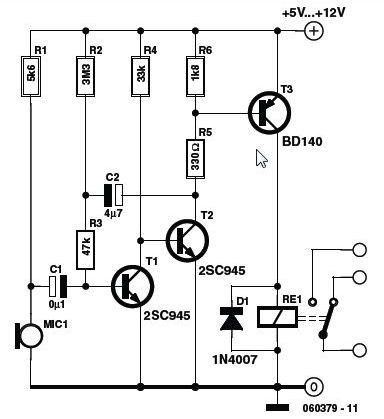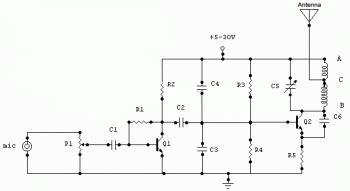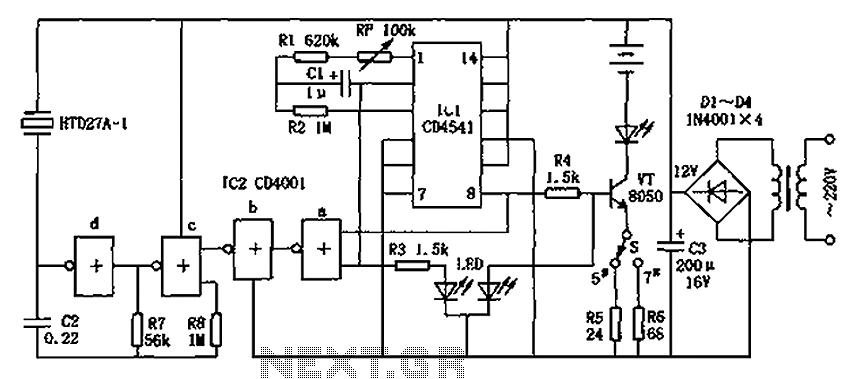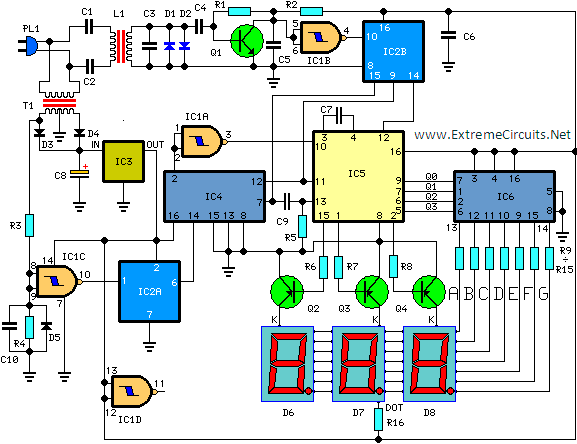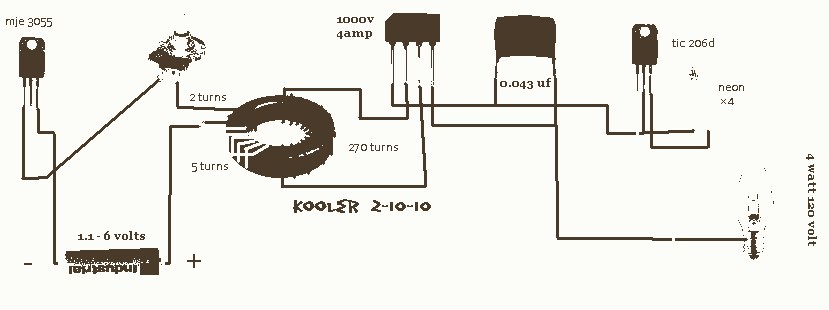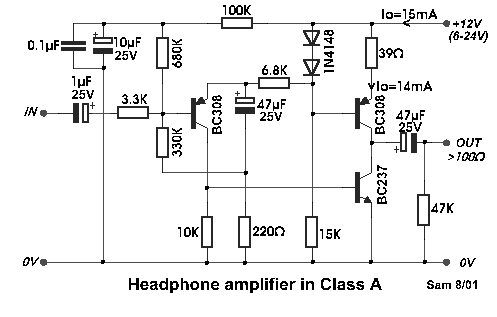
Voice modulator circuit
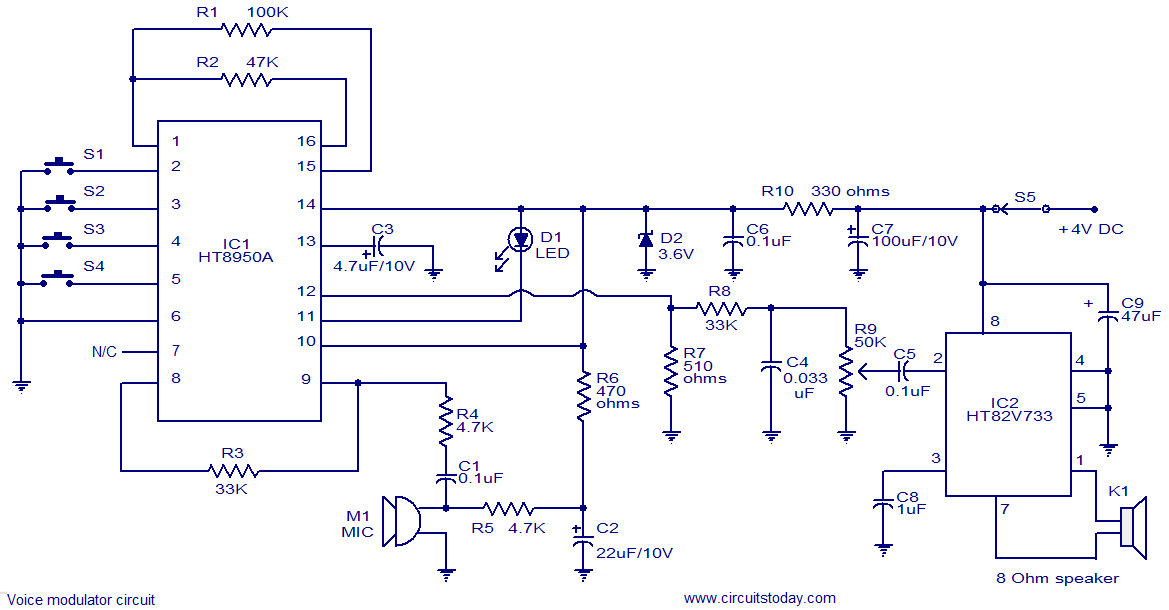
This is a versatile voice modulator circuit utilizing the HT8950A IC from Holtek Semiconductors. The IC can generate seven upward or downward frequency steps based on the input voice at a rate of 8 Hz. Additionally, it features two special variation effects: Vibrato mode and Robot mode. This circuit has numerous applications in systems such as telephony, speech processors, toys, and mixers. A microphone captures the input voice, while push button switches S2 and S3 are employed for frequency stepping in the upward and downward directions. Push button switch S1 activates the Vibrato mode, and push button switch S4 activates the Robot mode. The HT82V733 IC, also from Holtek, amplifies the output from the voice modulator. An LED (D1) indicates the voice level.
The voice modulator circuit described employs the HT8950A integrated circuit, which is specifically designed for voice modulation applications. This IC's capability to manipulate frequency allows it to create distinct audio effects, making it suitable for various entertainment and communication systems. The seven-step frequency modulation can enhance speech clarity or alter voice characteristics for creative applications.
The circuit's design includes a microphone that serves as the input transducer, capturing the user's voice. The output is processed by the HT8950A, which applies the selected modulation effect. The user can interact with the circuit through four push button switches: S2 and S3 for adjusting the frequency in either direction, S1 for activating the Vibrato effect, and S4 for engaging the Robot effect. This user-friendly interface allows for real-time manipulation of audio output.
The HT82V733 IC is integrated into the circuit to amplify the modulated voice signal, ensuring that the output is sufficiently powerful for further processing or direct playback. The inclusion of an LED indicator (D1) provides visual feedback on the voice level, allowing users to monitor the modulation effects dynamically.
Applications of this voice modulator circuit extend beyond simple voice alteration; it can be effectively utilized in toys to create engaging sound effects, in mixers for audio production, and in speech processors to enhance communication systems. The design's versatility and ease of use make it a valuable component in various electronic projects.This is a very versatile voice modulator circuit using IC HT8950A from Holtek Semiconductors. The IC is capable of creating 7 upward or downward steps on the frequency of the input voice at a rate of 8Hz. There is also two special variation effects namely Vibrato mode and Robot mode. This circuit finds a lot of application in systems like telephon e, speech processors, toys, mixers etc. A microphone is used to pick up the input voice. Push button switches S2 and S3 can be used for the upward and downward frequency stepping. Push button switch S1 can be used to activate Vibrato mode and push button switch S4 can be used to activate the Robot mode. IC HT82V733 (also from Holtek) is used to amplify the output of the voice modulator. LED D1 indicates the voice level. 🔗 External reference
The voice modulator circuit described employs the HT8950A integrated circuit, which is specifically designed for voice modulation applications. This IC's capability to manipulate frequency allows it to create distinct audio effects, making it suitable for various entertainment and communication systems. The seven-step frequency modulation can enhance speech clarity or alter voice characteristics for creative applications.
The circuit's design includes a microphone that serves as the input transducer, capturing the user's voice. The output is processed by the HT8950A, which applies the selected modulation effect. The user can interact with the circuit through four push button switches: S2 and S3 for adjusting the frequency in either direction, S1 for activating the Vibrato effect, and S4 for engaging the Robot effect. This user-friendly interface allows for real-time manipulation of audio output.
The HT82V733 IC is integrated into the circuit to amplify the modulated voice signal, ensuring that the output is sufficiently powerful for further processing or direct playback. The inclusion of an LED indicator (D1) provides visual feedback on the voice level, allowing users to monitor the modulation effects dynamically.
Applications of this voice modulator circuit extend beyond simple voice alteration; it can be effectively utilized in toys to create engaging sound effects, in mixers for audio production, and in speech processors to enhance communication systems. The design's versatility and ease of use make it a valuable component in various electronic projects.This is a very versatile voice modulator circuit using IC HT8950A from Holtek Semiconductors. The IC is capable of creating 7 upward or downward steps on the frequency of the input voice at a rate of 8Hz. There is also two special variation effects namely Vibrato mode and Robot mode. This circuit finds a lot of application in systems like telephon e, speech processors, toys, mixers etc. A microphone is used to pick up the input voice. Push button switches S2 and S3 can be used for the upward and downward frequency stepping. Push button switch S1 can be used to activate Vibrato mode and push button switch S4 can be used to activate the Robot mode. IC HT82V733 (also from Holtek) is used to amplify the output of the voice modulator. LED D1 indicates the voice level. 🔗 External reference
